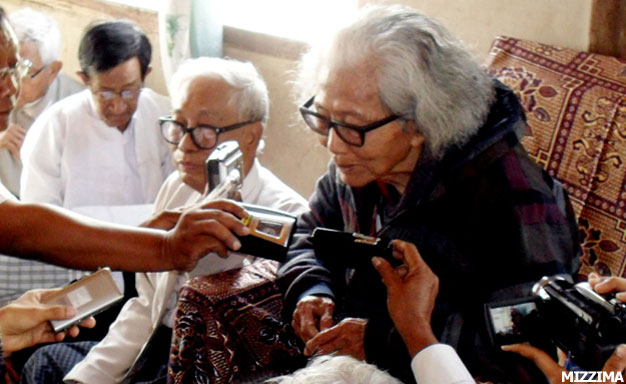Dagon Taryar, one of the fathers of the new-age Myanmar literature passed away at his residence in Aungban in Shan state at about 1:15 p.m. on August 19.

His niece and writer Thin Mya Sandi said, “We took him home from Aungban hospital at about 9 o’clock in the morning. He died of natural causes and did not suffer pain before his death.”
‘May’ his most famous novel was published in 1947. He won the Sarpay Beikman Literary award for his collection of short stories ‘Sabe Oo’ (The First Jasmine Blossom) in 1961. He was also awarded the Pakokku U Ohn Pe, Life Time Achievement award in 2001.
Some of his famous works are May, Irrawaddy-Yangtze-Volga, Kyar Pan Yay Sin (Sacred Water on Lotuses), Literary Theory, Literary Criticism, Literary Movements, Profiles (sketch biographies), Our Age Will Certainly Come One Day, Bewildered Spring Nights, Profiles Sketches at a Glance, Words, A Patch of Oil, A Harp String and Velvet Curtain.
Dagon Taryar's real name is Htay Myaing. He was born to U Ba Ohn and Daw Phwar Shin on Saturday May 10 1919, in Htaiku Myittan village in Kyaiklak Township, Ayeyarwady Division. He studied at the Myanmar medium Aung Zeya Mingala School in 7th Street of Yangon. He continued middle school at Kyaiklak National School from 1927 to 1936 and high school at the Yangon Yegyaw Methodist School from 1936 to 1937. He passed his matriculation exam in 1937 and studied at the Yangon University from 1937 to 1940.
He met Thakin Aung San, Thein Pe Myint, Kyaw Nyein, Ba Swe, Bo Zeya, student dictator Hla Shwe, etc. at the university. Thakin Ba Hein, the Communist leader, became his most intimate friend.
He loved paintings, music and poetry since his childhood. He started writing poetry at the age of 14. His early poems were written in classical forms, namely Ratu, Lutar, Ei-chin and Tayhtat. They were published in the Dagon Magazine.
His first short story ‘Hmoe Pyar Yi’ (Misty Scenery) was published in the February 1934 issue of the Tekkatho Theitpan (University Science) magazine under the pseudonym Myaing Thazin. He took up the pen name Dagon Taryar later. He started the Taryar magazine in December 1946 where he published Sarpay Thit (New Literature). He also worked as an editor for the magazine, while he was the editor at the Gandawin Journal (Classic Journal).
He used pseudonyms Myaing Thazin, Maung Nan Nwe, Saw Htut, Saw Tin Mu, Htay Myaing, Maung Thit Sar, Maung Ba Tint, Maung Sa, Banya Thiha, Maung Sein Mya, U Dagon, Maung Lin Htet, and Maung Kyar Nyunt, for writing articles and essays on a variety of subjects such as literature, literary criticism, poetry, paintings, films, music, art, etc. He also wrote a number of critical essays on issues such as human behavior.
Dagon Taryar worked as the representative of the All Burma Students’ Union, oilfield workers’, Executive Committee member of the University Students’ Union, editor of the Owei Magazine and Chairman of the Myanmar Writers’ Club. Moreover, he was also an Executive Committee member of Sino-Myanmar Friendship Association, Soviet-Myanmar Cultural and Friendship Association, Vice-Chairman of Standing Committee of World Peace Council and Chairman of Myanmar Poets’ Union.
Dagon Taryar was a close friend of Myanmar freedom fighters including the independence architect General Aung San. Later he devoted his life to literature together with writers such as Mya Than Tint, Kyaw Aung, Kyi Lin, and Bahmo Tin Aung. He published the Taryar (Stars) magazine with them.
He also devoted his life to campaigns for peace under the leadership of the great peace campaigner, poet Thakin Kodaw Hmaing. He worked in international and domestic peace campaigns actively. Even in the twilight of his life, bedridden Dagon Taryar released numerous statements and appeals for peace on earth.
When the Revolutionary Council led by General Ne Win took over power through a coup in 1962, many dissident politicians, workers, students and writers were detained. Dagon Taryar was also detained in Insein prison for three years and three months.


